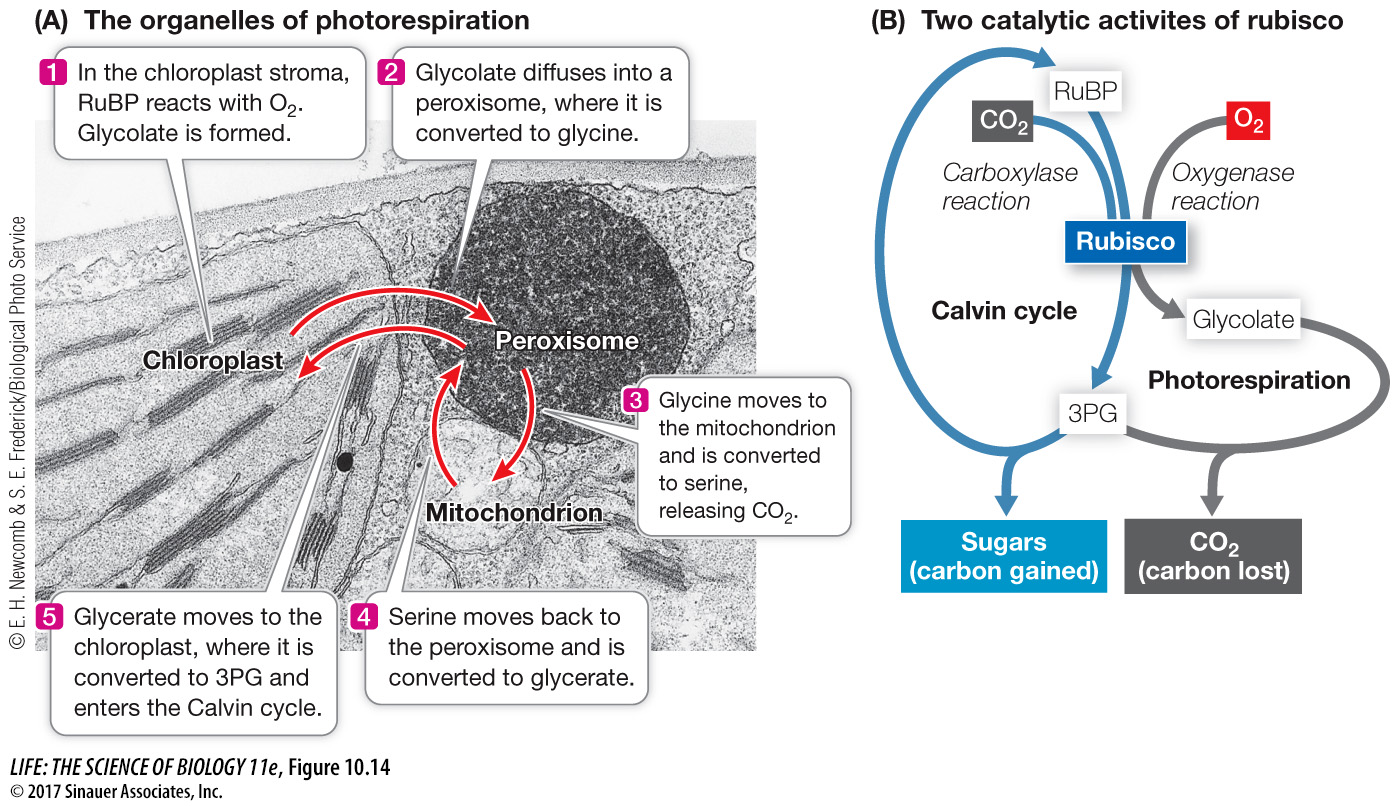How do some plants overcome the limitations of CO2 fixation?
As its full name indicates, rubisco (ribulose bisphosphate carboxylase/oxygenase) is an oxygenase as well as a carboxylase—it can add O2 or CO2, respectively, to the acceptor molecule RuBP:
Rubisco is a carboxylase when it adds CO2 to RuBP.
Rubisco is an oxygenase when it adds O2 to RuBP.
Think about the concentrations of O2 and CO2 in the typical air that you breathe. The concentration of CO2 in Earth’s atmosphere is about 400 ppm, or 0.04%. The concentration of O2 in the air is about 20%. You would think that if there were an “even competition” between CO2 and O2 for rubisco that the latter, with its higher concentration, would be favored. But such is not the case. It turns out that the affinity (binding) of rubisco for CO2 is much stronger than it is for O2, so in normal air inside a leaf, CO2 fixation is favored even though the concentration of CO2 in the air is far lower than that of O2. It is when there is an even higher concentration of O2 in the leaf relative to outside that O2 competes with the CO2, and rubisco combines RuBP with O2 rather than with CO2. This oxygenase activity reduces the overall amount of CO2 that can be converted into carbohydrates, and may play a role in limiting plant growth.
Relatively low O2 and high CO2 concentrations within the leaf favor carboxylase activity.
Relatively high O2 and low CO2 concentrations within the leaf favor oxygenase activity.
Under what conditions inside the leaf does the air have higher O2 and lower CO2, favoring the oxygenase activity? On a hot, dry day, small pores in the leaf surface called stomata close to prevent water from evaporating from the leaf (see Figure 10.1). But stomata closure also prevents gases from entering and leaving the leaf. If stomata are closed, the CO2 concentration in the leaf falls as CO2 is used up in photosynthetic reactions, and the O2 concentration rises because of these same reactions where water is used to form O2 (see Investigating Life: What Is the Chemistry of Photosynthesis, and How Will Increasing CO2 in the Atmosphere Affect It?). As the ratio of CO2 to O2 falls, the oxygenase activity of rubisco is favored.
The consequences of oxygenase activity and lower carboxylase activity are significant. When O2 is added to RuBP, one of the products is a two-
RuBP + O2 → phosphoglycolate + 3-
The 3PG formed by rubisco’s oxygenase activity enters the Calvin cycle, but the phosphoglycolate does not. Plants have evolved a metabolic pathway that can partially recover the carbon in phosphoglycolate. The phosphoglycolate is hydrolyzed to glycolate, which diffuses into peroxisomes (Figure 10.14). There, a series of reactions converts it into the amino acid glycine:
Glycolate + O2 → glycine (10.12)
The glycine then diffuses into a mitochondrion, where two glycine molecules are converted in a series of reactions into the amino acid serine, releasing CO2:
2 Glycine → serine + CO2 (10.13)
The serine moves into the peroxisome, where it is converted to glycerate. The glycerate then moves into the chloroplast, where it is phosphorylated to make 3PG, which enters the Calvin cycle. Note that it takes two phosphoglycolate molecules from Equation 10.11 to produce the two glycines used in Equation 10.13. So overall:
2 Phosphoglycolate (4 carbons) + O2 → 3PG (3 carbons) + CO2 (10.14)
This pathway thus reclaims 75 percent of the carbons from phosphoglycolate for the Calvin cycle. In other words, the reaction of RuBP with O2 instead of CO2 reduces the net carbon fixed by the Calvin cycle by 25 percent. The pathway is called photorespiration because it consumes O2 and releases CO2 and because it occurs only in the light (mediated by the same enzyme activation processes that we mentioned above with regard to the Calvin cycle).

Media Clip 10.1 Chloroplasts in Close-